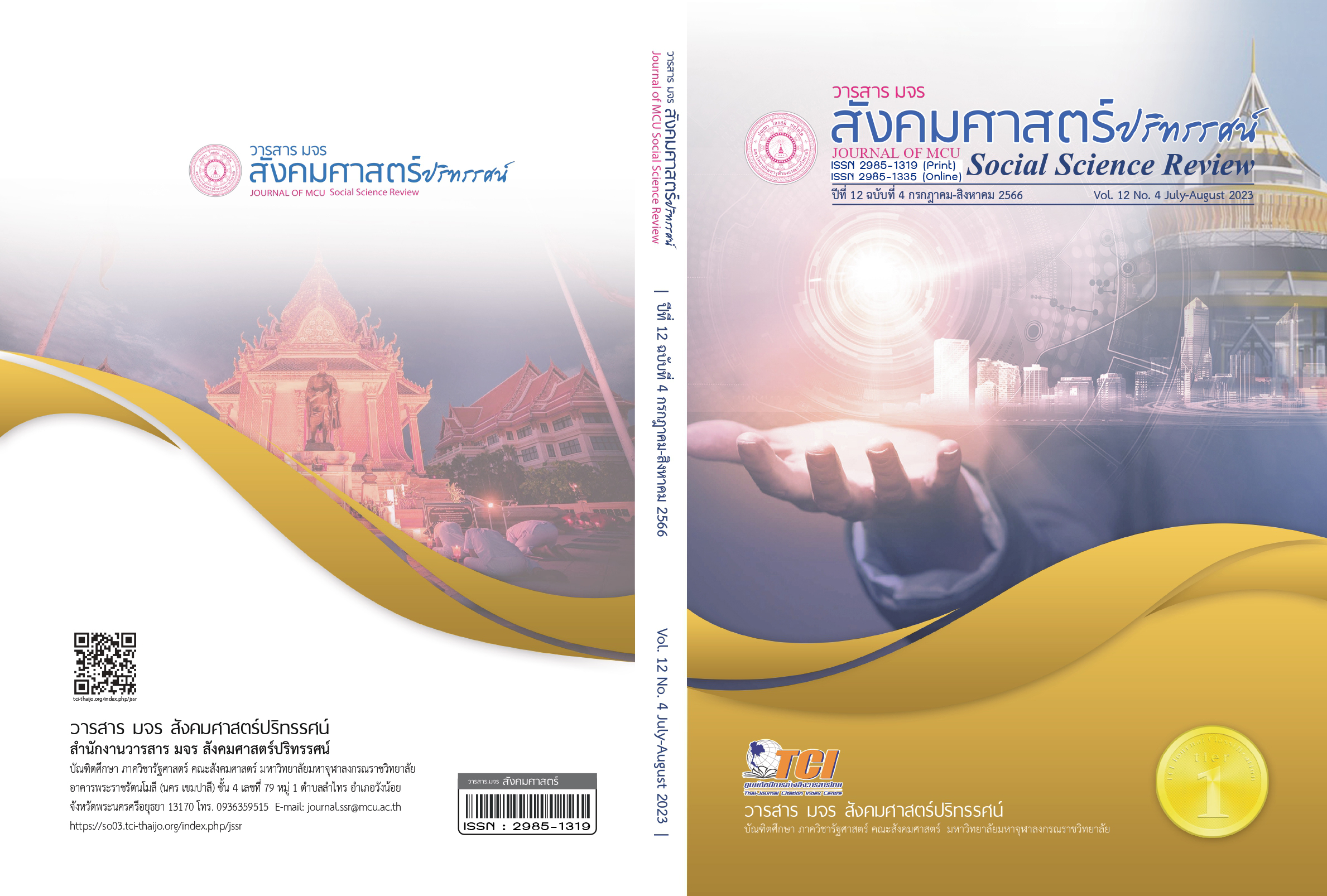LOVING-KINDNESS IN THAI TALES CALLED DUAI RAK BANDAN NITAN SI KHAO, 2550-2551 AND MYANMAR TALES CALLED KHIT THIT PONE PYIN, 2550-2553: NARRATIVE TECHNIQUES AND SOCIAL CONCEPTS
Keywords:
Loving-kindness, Social concepts, Narrative Techniques, Thai tales, Myanmar talesAbstract
The objectives of this qualitative research were 1. to study loving-kindness and social concepts and 2. to study narrative techniques. Data was gathered from Thai tales called “Duai Rak Bandan Nitan Si Khao” written by Art-ong Jumsai Na Ayudhya published in the years 2550-2551 as well as Myanmar tales called “Khit Thit Pone Pyin” written by “Kaung Thant” published in the years 2550-2553. The data was analyzed using the concept of loving-kindness and narrative techniques.
The findings of both Thai and Myanmar tales were loving-kindness between humans, humans and animals, and between animals. Furthermore, social concepts concerning the value of being family and relatives, the need for an authority to govern with integrity and morality and the benefit of loving-kindness were discovered. In terms of narrative techniques, title naming, which discloses the fundamental idea of the tale. The fables' two themes are that loving-kindness can lead to peace and that it is appropriate for all societal standards, including humans and animals. The Ideal type was frequently used by characters in Thai and Myanmar tales. Myanmar tales, on the other hand, featured a realistic personality type. In addition, dialogue played the specific role in revealing character altitude or personality.
References
กรรณิกา ศรีเจริญ. (2525). วิเคราะห์คุณธรรมในหนังสือการ์ตูนเล่มละบาท. บรรณศาสตร์, 5(2), 40-66.
กฤษตยา ณ หนองคาย. (2544). การศึกษาวิเคราะห์วรรณกรรมสำหรับเด็กก่อนวัยรุ่นที่ได้รับรางวัล ตั้งแต่ปี พ.ศ. 2522-2542 (วิทยานิพนธ์ปริญญาอักษรศาสตรมหาบัณฑิต.สาขาวิชาภาษาไทย). กรุงเทพฯ: จุฬาลงกรณ์มหาวิทยาลัย.
กิ่งแก้ว อัตถากร. (2519). วรรณกรรมจากบ้านใน. กรุงเทพฯ: กรมการฝึกหัดครู.
จุฑามาศ สุขขำจรูญ. (2549). การวิเคราะห์วรรณกรรมสำหรับเด็กของ ส. พุ่มสุวรรณ (สารนิพนธ์การศึกษามหาบัณฑิต สาขาภาษาไทย). กรุงเทพฯ: มหาวิทยาลัยศรีนครินทรวิโรฒ.
ฉันทนา เย็นนาน. (2539). การศึกษาวิเคราะห์นิทานพื้นบ้านภาคกลาง. (ปริญญานิพนธ์การศึกษามหาบัณฑิต สาขาภาษาไทย). กรุงเทพฯ: มหาวิทยาลัยศรีนครินทรวิโรฒ.
เฉลิม มากนวล (2518). การวิเคราะห์และเปรียบเทียบนิทานชาดกกับนนิทานอีสป. กรุงเทพฯ: กรมการฝึกหัดครู.
อาจอง ชุมสาย ณ อยุธยา. (2550). ด้วยรักบันดาล...นิทานสีขาว (เล่ม 1). กรุงเทพฯ: ฟรีมายด์.
_____. (2550). ด้วยรักบันดาล...นิทานสีขาว (เล่ม 2). กรุงเทพฯ: ฟรีมายด์.
_____. (2551). ด้วยรักบันดาล....นิทานสีขาว (เล่ม 3). กรุงเทพฯ: ฟรีมายด์.
_____. (2551). ด้วยรักบันดาล....นิทานสีขาว (เล่ม 4). กรุงเทพฯ: ฟรีมายด์.
ธนัญชย์ ชัยวุฒิมากร และบุปผา บุญทิพย์. (2559). แนวคิดคุณธรรมในนิทานสมัยใหม่:ด้วยรัก บันดาล...นิทานสีขาว ของอาจอง ชุมสาย ณ อยุธยา. วารสารวิชาการบัณฑิตวิทยาลัยสวนดุสิต, 12(2), 149-166.
มัทนา ขุนศรี และคณะ. (2564). นิทานพื้นบ้านไทยและเมียนมา: การศึกษาเปรียบเทียบกลวิธีการเล่าเรื่องและกฎเกณฑ์นิทานพื้นบ้านของเอกเซลโอลริค. พิฆเนศวร์สาร, 17(1), 28-36.
วราคม ทีสุกะ. (2528). ความคิดทางสังคมและทฤษฎีทางสังคมวิทยา. กรุงเทพฯ : สร้างสรรค์.
Kaung Thant. (2550). Khint Thit Pone Pyin (เล่ม 1). Yangon: Kaung Thant Sapay.
_____. (2551). Khint Thit Pone Pyin (เล่ม 2). Yangon: Kaung Thant Sapay.
_____. (2552). Khint Thit Pone Pyin (เล่ม 3). Yangon: Kaung Thant Sapay.
_____. (2553). Khint Thit Pone Pyin (เล่ม 4). Yangon: Kaung Thant Sapay.
_____. (2553). Khint Thit Pone Pyin (เล่ม 5). Yangon: Kaung Thant Sapay.
Downloads
Published
How to Cite
Issue
Section
License
Copyright (c) 2023 Journal of MCU Social Science Review

This work is licensed under a Creative Commons Attribution-NonCommercial-NoDerivatives 4.0 International License.
In order to conform the copyright law, all article authors must sign the consignment agreement to transfer the copyright to the Journal including the finally revised original articles. Besides, the article authors must declare that the articles will be printed in only the Journal of MCU Journal of Social Sciences. If there are pictures, tables or contents that were printed before, the article authors must receive permission from the authors in writing and show the evidence to the editor before the article is printed. If it does not conform to the set criteria, the editor will remove the article from the Journal without any exceptions.





